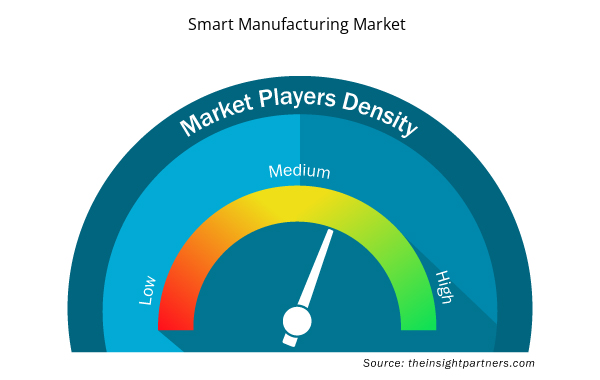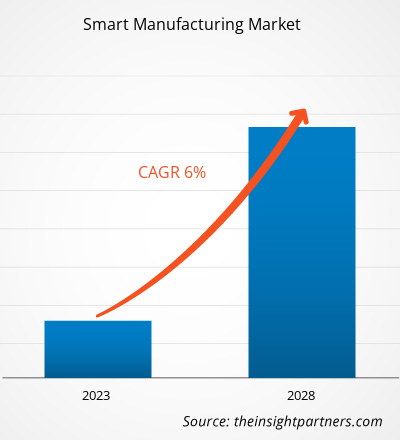[調査レポート] スマート製造市場は、2022年の2,496.28億米ドルから2028年には3,652.2億米ドルに成長すると予想されており、2022年から2028年にかけて6.0%のCAGRで成長すると予測されています。
アナリストの視点:
スマート製造市場は近年、著しい成長と革新を遂げています。スマート製造、またはインダストリー 4.0 または第 4 次産業革命とは、人工知能 (AI)、モノのインターネット (IoT)、クラウド コンピューティング、ビッグ データ分析、ロボット工学などの高度なテクノロジーを製造業に統合することを指します。スマート製造ソリューションは、効率、生産性、柔軟性を高めることで、従来の製造業務を変革しました。これらのテクノロジーにより、リアルタイムの監視、自動化、予測メンテナンス、インテリジェントな意思決定が可能になり、品質管理の改善、ダウンタイムの削減、サプライ チェーンの最適化、コスト削減が実現します。スマート製造市場には、自動車、航空宇宙、電子機器、医薬品、食品および飲料、消費財など、さまざまな分野が含まれます。特に自動車業界は、生産を合理化し、製品のカスタマイズを強化し、電気自動車や自動運転の高まるニーズに対応するために、スマート製造プラクティスを採用しています。運用効率の向上に加えて、スマート製造は持続可能性と環境への影響に重点を置いています。リソースの利用を最適化し、廃棄物を削減し、エネルギー効率の高いプラクティスを実装することで、製造業者は二酸化炭素排出量を最小限に抑え、持続可能な開発に貢献できます。今後数年間、世界のスマート製造市場は成長すると予想されています。この成長を牽引する要因としては、自動化の需要増加、リアルタイムデータ分析と予測メンテナンスの必要性、IoTデバイスとクラウドプラットフォームの導入増加などが挙げられます。さらに、5G接続やエッジコンピューティングなどの技術進歩により、スマート製造ソリューションの導入が加速すると予想されています。
市場概要:
「スマート製造」という用語は、世界中でますます導入されている革新的で統合された生産技術とソリューションの開発に基づくグローバルな産業戦略を表しています。生産オペレーションを最適かつスケーラブルに制御するには、インターネットを使用して機械が相互接続されたシステムを製造工場に導入する必要があります。スマート製造のよく知られた技術には、産業用モノのインターネット (IIoT)、製造におけるブロックチェーン、ロボット工学、ERP システム、予防保守、拡張現実と仮想現実、データ分析、自動パッケージングなどがあります。このため、産業企業は、生産効率を高めるためにこれらの技術を適用する新しい方法への投資と開発を続けています。また、市場製品の強化に向けた取り組みも拡大しています。次世代のスマート製造プラットフォームとスマート ファクトリー接続は、スマート製造リーダーシップ連合として知られる米国を拠点とする産業組織、技術サプライヤー、研究開発施設、大学の連合によって作成されています。
要件に合わせてレポートをカスタマイズする
このレポートの一部、国レベルの分析、Excelデータパックなど、あらゆるレポートを無料でカスタマイズできます。また、スタートアップや大学向けのお得なオファーや割引もご利用いただけます。
- このレポートの主要な市場動向を入手してください。この無料サンプルには、市場動向から見積もりや予測に至るまでのデータ分析が含まれます。
市場の推進要因:
産業用ロボットの導入増加がスマート製造市場の成長を促進
ますます多くの産業が自動化を必要とするにつれて、産業用ロボットの導入が増加しています。産業用ロボットは、エレクトロニクス分野の拡大と製造業の人件費の上昇により、市場の成長に貢献してきました。これにより、調査期間中に産業用ロボットの需要が高まり、スマート製造の市場成長を支える可能性があります。グリーンテクノロジーとエネルギー効率への注目が高まる結果、企業は、より少ない電力を使用し、よりエネルギー効率の高いスマート製造を実現することで、市場シェアを拡大し、新しい顧客を引き付けることができます。グリーンシステムへの投資は、予測期間中に驚異的な額で増加すると予想されています。産業用ロボットは、製品の効率、生産性、品質を向上させるために、製造業界でますます使用されています。産業用ロボットは、高い精度、速度、正確さで反復的なタスクを実行できるため、エラーが減り、製品の品質が向上します。安全でない環境での作業やかなりの大きさの物体の移動など、人間が実行するのが危険または困難なタスクも、ロボットによって実行されます。産業用ロボットの採用増加に対応して、ロボットをよりスマートかつ効率的にする機械学習、人工知能、モノのインターネット (IoT) などの新しいテクノロジーも開発されています。これらのテクノロジーは、人間や他のロボットと連携して複雑な製造タスクを遂行できる新世代のスマート ロボットの作成に役立ちます。産業用ロボットの採用増加は、製造プロセスを最適化し、製品の品質を向上させるために使用される自動化ソリューション、データ分析、その他のテクノロジーの需要の増加によって、スマート製造市場の拡大も促進しています。
セグメント分析:
エンドユーザーに基づいて、スマート製造市場はディスクリート産業とプロセス産業に分類されます。ディスクリートセグメントは2020年に最大の市場シェアを占め、予測期間中に市場で最高のCAGRを記録すると予想されています。スマート製造市場のディスクリートセグメントは、自動車、航空宇宙、防衛などのディスクリート製造プロセスにおける自動化とデジタル化の需要が高まっているため、最大のシェアを占めています。これらの業界でスマート製造技術を採用することで、効率性の向上、コストの削減、品質管理の強化が実現しました。これにより、スマート製造ソリューションの需要が高まり、市場のディスクリートセグメントの成長が促進されました。さらに、インダストリー4.0と産業用IoT(IIoT)への注目が高まることで、スマート製造市場のディスクリートセグメントの成長がさらに促進されると予想されます。
地域分析:
アジア太平洋地域のスマート製造市場は、2022年に787億6,000万米ドルと評価され、2028年までに1億1,153万米ドルに達すると予測されています。予測期間中、5.5%のCAGRで成長すると見込まれています。アジア太平洋地域は最大の市場シェアを占めました。予測期間中、この地域は最も速い成長を経験することも予想されています。中国やインドなどの発展途上国は、これらの市場に多くの未開拓の見込みがあるため、スマート製造の完全な自動化を追求しています。いくつかの要因により、アジア太平洋地域はスマート製造市場の支配的なプレーヤーとなっています。この地域が優位に立っている主な理由の1つは、政府や民間組織が高度な製造技術の開発に多額の投資を行っていることです。中国、日本、韓国などの国は、製造プロセスを改善し、生産性を向上させるために、ロボット工学、人工知能、モノのインターネット(IoT)などの技術の開発に多額の投資を行っています。政府および民間部門の投資に加えて、アジア太平洋地域には、高度な製造技術の開発と導入に不可欠な、広範囲で熟練した労働力があります。この地域には、製造部門で新しい技術を開発して実装できる高度なスキルを持つエンジニア、科学者、技術者が多数います。また、アジア太平洋地域には、特にエレクトロニクスおよび自動車部門で、世界有数の製造企業が数多く拠点を置いています。これらの企業は、効率性の向上、コストの削減、生産性の向上を目的とした高度な製造技術の開発に多額の投資を行っています。その結果、この地域は製造部門のイノベーションの中心地になりつつあり、多くの新しい技術が開発され、世界中で展開される前にテストされています。
カスタマイズ製品に対する需要の高まりも、アジア太平洋地域のスマート製造市場の発展を後押ししています。消費者の要求が厳しくなり、ニーズを満たす製品を期待するようになるにつれ、メーカーは 3D 印刷や機械学習などの高度な技術を利用して、カスタマイズ製品を迅速かつ効率的に作成しています。アジア太平洋地域は、世界をリードする 3D 印刷会社の多くがこの地域に拠点を置いており、このトレンドを活用できる好位置にいます。最後に、アジア太平洋地域は、製造業におけるクラウド コンピューティングとビッグ データ分析の支持が高まっていることからも恩恵を受けています。これらの技術は、センサー、マシン、その他のデバイスなど、さまざまなソースから大量のデータを収集して分析し、製造プロセスと製品品質の改善に利用できるパターンと傾向を特定するために使用されています。この地域には、大規模で成長を続けるクラウド コンピューティング インフラストラクチャがあり、製造部門でのこれらの技術の採用を促進しています。
主要プレーヤー分析:
スマート製造市場分析には、横河電機株式会社、シスコシステムズ株式会社、ハネウェルインターナショナル株式会社、3Dシステムズ株式会社、株式会社ダイフク、ゼネラルエレクトリック、IBM株式会社、オラクル株式会社、シーメンスAG、シュナイダーエレクトリックSEなどの企業が含まれています。スマート製造の企業の中では、シスコシステムズ株式会社とシーメンスAGが、多様な製品ポートフォリオを提供していることから、トップ2の企業となっています。
スマート製造市場の地域別洞察
予測期間を通じてスマート製造市場に影響を与える地域的な傾向と要因は、Insight Partners のアナリストによって徹底的に説明されています。このセクションでは、北米、ヨーロッパ、アジア太平洋、中東、アフリカ、南米、中米にわたるスマート製造市場のセグメントと地理についても説明します。

- スマート製造市場の地域別データを入手
スマート製造市場レポートの範囲
| レポート属性 | 詳細 |
|---|---|
| 2022年の市場規模 | 2,587.2億米ドル |
| 2028年までの市場規模 | 3,652.2億米ドル |
| 世界のCAGR(2022年 - 2028年) | 6.0% |
| 履歴データ | 2020-2021 |
| 予測期間 | 2023-2028 |
| 対象セグメント | エンドユーザー別
|
| 対象地域と国 | 北米
|
| 市場リーダーと主要企業プロフィール |
|
スマート製造市場のプレーヤー密度:ビジネスダイナミクスへの影響を理解する
スマート製造市場は、消費者の嗜好の変化、技術の進歩、製品の利点に対する認識の高まりなどの要因により、エンドユーザーの需要が高まり、急速に成長しています。需要が高まるにつれて、企業は提供を拡大し、消費者のニーズを満たすために革新し、新たなトレンドを活用し、市場の成長をさらに促進しています。
市場プレーヤー密度とは、特定の市場または業界内で活動している企業または会社の分布を指します。これは、特定の市場スペースに、その市場規模または総市場価値に対してどれだけの競合相手 (市場プレーヤー) が存在するかを示します。
スマート製造市場で事業を展開している主要企業は次のとおりです。
- 横河電機株式会社
- シスコシステムズ株式会社
- ハネウェルインターナショナル株式会社
- 3Dシステムズ株式会社
- 株式会社ダイフク
免責事項:上記の企業は、特定の順序でランク付けされていません。

- スマート製造市場のトップキープレーヤーの概要を入手
最近の動向:
スマート製造市場の企業では、合併や買収などの無機的および有機的な戦略が広く採用されています。最近の主要な市場動向をいくつか以下に示します。
- 2022年10月 - ABBは、ミッションクリティカルな用途向け高出力ターボチャージャーのパイオニアであるAccelleron Industries AGが、チューリッヒのスイス証券取引所でティッカーシンボル「ACLN」で取引を開始することを承認されたと発表しました。これは、AccelleronのABBからのスピンオフを完了するためのものです。
- 2022 年 7 月 - ABB と SKF は、製造プロセスの自動化における協力の可能性を探るための覚書 (MoU) を締結しました。このパートナーシップを通じて、両社は製造能力を向上させ、顧客の生産効率の向上をサポートするためのソリューションを特定および評価します。
- 過去2年間の分析、基準年、CAGRによる予測(7年間)
- PEST分析とSWOT分析
- 市場規模価値/数量 - 世界、地域、国
- 業界と競争環境
- Excel データセット



Report Coverage
Revenue forecast, Company Analysis, Industry landscape, Growth factors, and Trends

Segment Covered
This text is related
to segments covered.

Regional Scope
North America, Europe, Asia Pacific, Middle East & Africa, South & Central America

Country Scope
This text is related
to country scope.
よくある質問
APAC is the fastest-growing regional market in the global Smart manufacturing market in 2021.
The global smart manufacturing market was valued at US$ 258.72 Bn in 2022
The Future trends impacting the smart manufacturing market are:
1. 3D robotics
2. AI
3. IoT technologies
The hardware segment led the smart manufacturing in 2021.
US, Germany, India, South Africa, and Brazil are the countries are registering a high growth rate during the forecast period.
The global smart manufacturing market size is projected to reach US$ 365.22 Bn by 2028.
The driving factors impacting the Smart manufacturing market are
1. Surging Adoption of RTLS
2. Increasing Trend of Industry 4.0
The incremental growth of the smart manufacturing market during the forecast period is US$ 22.0 billion with a CAGR of 6.0%
The key players holding the major market share of smart manufacturing are General Electric Company; Honeywell International Inc.; Oracle Corporation; Schneider Electric SE; Siemens AG; Hitachi Ltd; Alstom SA; Irdeto; Raytheon Technologies Corporation; and ENSCO Inc.
Trends and growth analysis reports related to Technology, Media and Telecommunications : READ MORE..
The List of Companies - Smart Manufacturing Market
- Yokogawa Electric Corporation
- Cisco Systems, Inc
- Honeywell International Inc.
- 3D Systems, Inc
- Daifuku Co., Ltd
- GENERAL ELECTRIC
- IBM Corporation
- Oracle Corporation
- Siemens AG
- Schneider Electric SE
The Insight Partners performs research in 4 major stages: Data Collection & Secondary Research, Primary Research, Data Analysis and Data Triangulation & Final Review.
- Data Collection and Secondary Research:
As a market research and consulting firm operating from a decade, we have published and advised several client across the globe. First step for any study will start with an assessment of currently available data and insights from existing reports. Further, historical and current market information is collected from Investor Presentations, Annual Reports, SEC Filings, etc., and other information related to company’s performance and market positioning are gathered from Paid Databases (Factiva, Hoovers, and Reuters) and various other publications available in public domain.
Several associations trade associates, technical forums, institutes, societies and organization are accessed to gain technical as well as market related insights through their publications such as research papers, blogs and press releases related to the studies are referred to get cues about the market. Further, white papers, journals, magazines, and other news articles published in last 3 years are scrutinized and analyzed to understand the current market trends.
- Primary Research:
The primarily interview analysis comprise of data obtained from industry participants interview and answers to survey questions gathered by in-house primary team.
For primary research, interviews are conducted with industry experts/CEOs/Marketing Managers/VPs/Subject Matter Experts from both demand and supply side to get a 360-degree view of the market. The primary team conducts several interviews based on the complexity of the markets to understand the various market trends and dynamics which makes research more credible and precise.
A typical research interview fulfils the following functions:
- Provides first-hand information on the market size, market trends, growth trends, competitive landscape, and outlook
- Validates and strengthens in-house secondary research findings
- Develops the analysis team’s expertise and market understanding
Primary research involves email interactions and telephone interviews for each market, category, segment, and sub-segment across geographies. The participants who typically take part in such a process include, but are not limited to:
- Industry participants: VPs, business development managers, market intelligence managers and national sales managers
- Outside experts: Valuation experts, research analysts and key opinion leaders specializing in the electronics and semiconductor industry.
Below is the breakup of our primary respondents by company, designation, and region:

Once we receive the confirmation from primary research sources or primary respondents, we finalize the base year market estimation and forecast the data as per the macroeconomic and microeconomic factors assessed during data collection.
- Data Analysis:
Once data is validated through both secondary as well as primary respondents, we finalize the market estimations by hypothesis formulation and factor analysis at regional and country level.
- Macro-Economic Factor Analysis:
We analyse macroeconomic indicators such the gross domestic product (GDP), increase in the demand for goods and services across industries, technological advancement, regional economic growth, governmental policies, the influence of COVID-19, PEST analysis, and other aspects. This analysis aids in setting benchmarks for various nations/regions and approximating market splits. Additionally, the general trend of the aforementioned components aid in determining the market's development possibilities.
- Country Level Data:
Various factors that are especially aligned to the country are taken into account to determine the market size for a certain area and country, including the presence of vendors, such as headquarters and offices, the country's GDP, demand patterns, and industry growth. To comprehend the market dynamics for the nation, a number of growth variables, inhibitors, application areas, and current market trends are researched. The aforementioned elements aid in determining the country's overall market's growth potential.
- Company Profile:
The “Table of Contents” is formulated by listing and analyzing more than 25 - 30 companies operating in the market ecosystem across geographies. However, we profile only 10 companies as a standard practice in our syndicate reports. These 10 companies comprise leading, emerging, and regional players. Nonetheless, our analysis is not restricted to the 10 listed companies, we also analyze other companies present in the market to develop a holistic view and understand the prevailing trends. The “Company Profiles” section in the report covers key facts, business description, products & services, financial information, SWOT analysis, and key developments. The financial information presented is extracted from the annual reports and official documents of the publicly listed companies. Upon collecting the information for the sections of respective companies, we verify them via various primary sources and then compile the data in respective company profiles. The company level information helps us in deriving the base number as well as in forecasting the market size.
- Developing Base Number:
Aggregation of sales statistics (2020-2022) and macro-economic factor, and other secondary and primary research insights are utilized to arrive at base number and related market shares for 2022. The data gaps are identified in this step and relevant market data is analyzed, collected from paid primary interviews or databases. On finalizing the base year market size, forecasts are developed on the basis of macro-economic, industry and market growth factors and company level analysis.
- Data Triangulation and Final Review:
The market findings and base year market size calculations are validated from supply as well as demand side. Demand side validations are based on macro-economic factor analysis and benchmarks for respective regions and countries. In case of supply side validations, revenues of major companies are estimated (in case not available) based on industry benchmark, approximate number of employees, product portfolio, and primary interviews revenues are gathered. Further revenue from target product/service segment is assessed to avoid overshooting of market statistics. In case of heavy deviations between supply and demand side values, all thes steps are repeated to achieve synchronization.
We follow an iterative model, wherein we share our research findings with Subject Matter Experts (SME’s) and Key Opinion Leaders (KOLs) until consensus view of the market is not formulated – this model negates any drastic deviation in the opinions of experts. Only validated and universally acceptable research findings are quoted in our reports.
We have important check points that we use to validate our research findings – which we call – data triangulation, where we validate the information, we generate from secondary sources with primary interviews and then we re-validate with our internal data bases and Subject matter experts. This comprehensive model enables us to deliver high quality, reliable data in shortest possible time.


 このレポートの無料サンプルを入手する
このレポートの無料サンプルを入手する